Mastering Clarity: Unveiling the Power of Extra Low Dispersion (ED) Glass in Optics
Introduction:
In recent years, the utilization of Extra Low Dispersion Glass (ED Glass) in binocular lenses has seen a significant surge. What was once confined to only the upper echelons of "super" binoculars has now become quite commonplace, even in relatively budget-friendly models.
With numerous manufacturers incorporating ED Glass into their designs, it begs the question: what exactly does it signify, why is it employed, and how does it elevate the viewing experience through your optics? If you're not already acquainted with these answers, fear not, as this article aims to unravel these queries. However, be forewarned, delving into the intricacies of this subject might get a tad technical. So, hold onto your hats as we embark on this enlightening journey, where I'll endeavor to elucidate to the best of my understanding and as straightforwardly as possible.
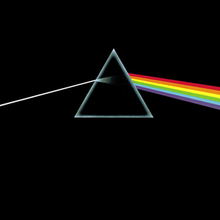
Dispersion in Optics:
Before delving into the superiority of one glass type over another, let's first acquaint ourselves with the concept of dispersion and its significance in the realm of optics.
As many are aware, particularly fans of Pink Floyd, passing light through a prism results in the dispersion of white light into its constituent colors. The blue spectrum is refracted the most, while the red spectrum is refracted the least.
Hence, a prism disperses or spreads out the colors comprising white light, and dispersion is essentially a measure of the extent to which these colors are spread out.

Dispersion in Lenses:
The lenses within your binoculars are tasked with focusing the captured light onto a single point. However, akin to a prism, a certain degree of dispersion occurs as light traverses the lens, causing different wavelengths of light to focus at marginally varied positions. This optical distortion, known as chromatic aberration, manifests as color fringes surrounding the produced image.
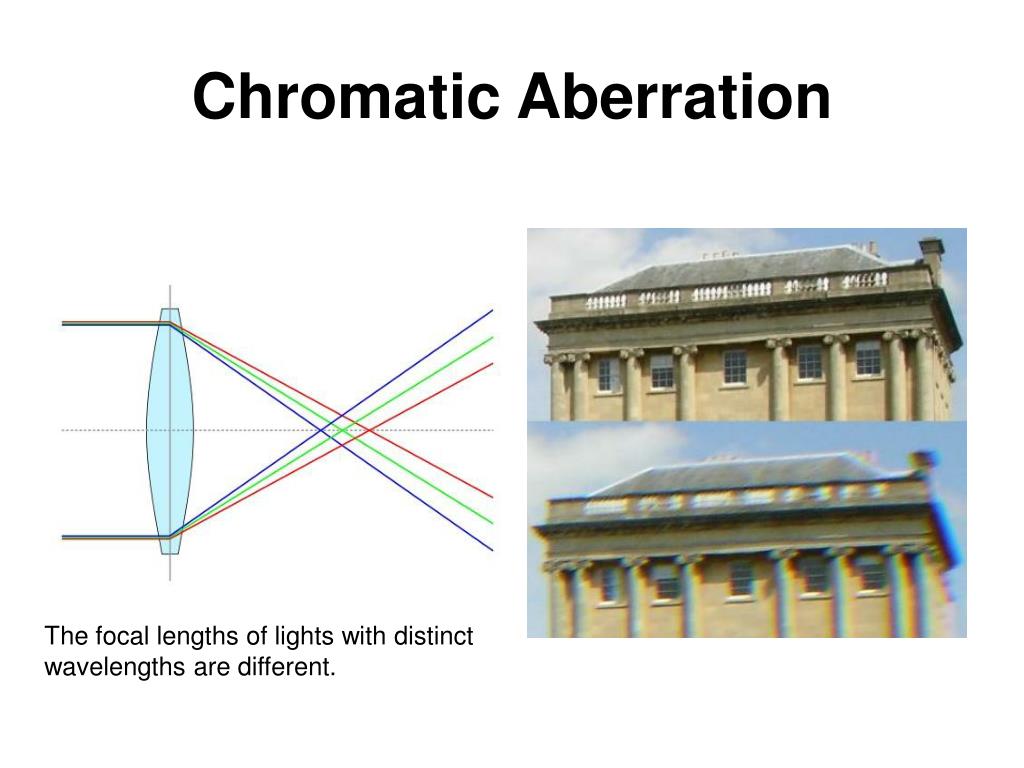
Color Fringing Caused by Chromatic Aberration:
The image above aptly illustrates the color fringing observed around the edges of the flower, a result of viewing it through a lens afflicted with chromatic aberration.
Mitigating Dispersion:
While there are scenarios where splitting light wavelengths is advantageous, color fringing is certainly unwelcome in binoculars. Hence, the objective lenses must gather all these diverse wavelengths of light and converge them onto a single point. Therefore, reducing dispersion inherently lessens chromatic aberration, subsequently minimizing the color fringing around the image.
Various methods are employed to achieve this, often employing a combination for optimal results:
Compound Lenses:
A single lens, comprising a solitary optical element, cannot rectify chromatic aberration. Hence, compound lenses are utilized, composed of multiple lens elements with distinct optical characteristics, dispersing wavelengths of light differentially. These elements are then fused to form a single lens, which, when meticulously designed, aids in correcting this aberration.
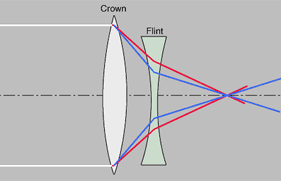
Achromatic Doublet Lens:
The most prevalent type of compound lens employed to diminish chromatic aberration in binocular objective lenses is the achromatic doublet, comprising two lens elements with differing dispersion properties. Typically, an achromatic doublet consists of a low dispersion crown glass and a high dispersion flint glass. Though a significant advancement over a single lens in reducing chromatic aberration within a specific wavelength range, they do not achieve flawless correction.
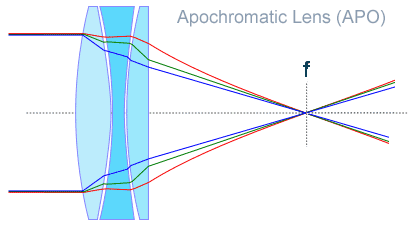
Apochromatic Lens (APO):
An apochromat, or apochromatic lens, typically comprises three elements, converging light of three distinct frequencies to a common focus. These lenses offer superior correction of chromatic aberration, coupled with enhanced correction of spherical aberration compared to achromatic doublets.
Extra Low Dispersion Glass (ED Glass):
However, the narrative doesn't conclude here. Diverse lens materials, such as specialized coatings or lenses crafted from distinct types of glass, may also be employed to minimize chromatic aberrations.
As previously discussed, an achromatic lens, fashioned with conventional glass materials, can align focal lengths for two different wavelengths, like red and blue. However, residual chromatic aberration persists due to varying focal lengths for other wavelengths, such as green, leading to a secondary spectrum.
This secondary spectrum conundrum eludes resolution using conventional glass combinations. However, specific optical materials, endowed with anomalous partial dispersion characteristics, can address this issue. ED (Extra-low Dispersion) glass possesses this unique attribute, and when amalgamated with other glasses, it mitigates the effects of the secondary spectrum. Compared to an achromatic lens crafted with standard glass, ED glass dramatically reduces chromatic aberration, and consequently, color fringing.
However, such specialized glass types often command a higher price and are thus sparingly utilized unless imperative. Furthermore, their deployment necessitates meticulous orchestration with other elements of a particular type to balance overall performance.
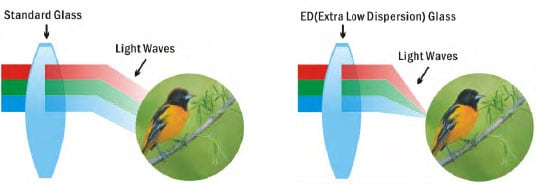
Summary:
Extra-low dispersion glass combats or diminishes chromatic aberration by affording multi-element objective lens designers more flexibility to concentrate and direct light wavelengths more effectively. Consequently, they can regulate and minimize aberrations, particularly chromatic aberration. Broadly speaking, more adept aberration control correlates with a cleaner, brighter image.
Consequently, the majority of premium optics now boast extra-low dispersion glass lenses. Cameras equipped with this glass tend to capture clearer, sharper images with minimal or no color fringing, while binoculars and telescopes transmit clearer, sharper images to the observer's eyes.
Additional Features of ED Glass:
-
ED glass exhibits less stability with temperature fluctuations compared to conventional glass, causing slight focal length variations.
-
ED glass possesses a low index of refraction, necessitating more deeply curved elements for equivalent focal lengths.
ED Glass (Extra Low Dispersion) vs. Standard Glass:
The illustration above, courtesy of Vanguard Sport Optics, vividly illustrates the disparity between employing standard glass and extra-low dispersion glass (ED glass).
In conclusion, the integration of Extra Low Dispersion Glass (ED Glass) in optical equipment represents a notable advancement, elevating the viewing experience by mitigating chromatic aberrations and enhancing image clarity. Through meticulous engineering and utilization of specialized materials, manufacturers continue to push the boundaries of optical performance, ensuring that enthusiasts and professionals alike can appreciate the world with unprecedented clarity and precision.

